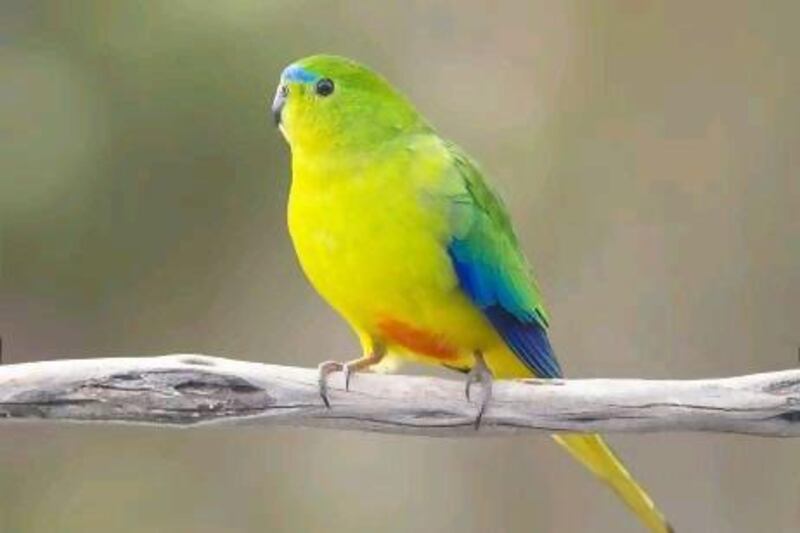SYDNEY // One of the world's most endangered birds, the orange-bellied parrot, is becoming famous for the wrong reasons in its native Australia. Not because of its rarity - there are believed to be just 50 individuals left in the wild - but because the tiny, shy bird has foiled a series of multi-million-dollar developments.
A few years ago, the parrot, which conservationists call the OBP, almost stopped a big wind farm being built in Victoria. Last month, it forced the development of a A$50 million (Dh194 million) marina near Melbourne to be put on hold while the federal government assesses its impact on OBP habitat - although no parrots have been spotted in the area for 25 years.
The OBP is a migratory bird, which is unusual for a parrot. It breeds in the Tasmanian wilderness, then flies to the mainland to feed, mainly in the Victorian coastal flats. Its numbers have declined dramatically over the past decade. Habitat degradation, introduced predators and the infertility of many females, possibly the result of inbreeding, have caused the decline.
A ground-feeding bird with a brilliant green, yellow and blue plumage - plus an orange patch - the parrot first achieved notoriety in the 1990s, when proposals to relocate a Victorian chemical plant sparked controversy because the site jeopardised its habitat. The then state premier, Jeff Kennett, branded it a "trumped-up corella". The corella, a type of cockatoo, is common in Australian backyards.
In 2006, the OBP was back in the limelight, after the federal government vetoed a Victorian wind farm amid fears that migrating birds might collide with the turbines. The decision was later reversed. Now Canberra has stepped in again, declaring that the marina expansion at Western Harbour, south-east of Melbourne, could threaten the parrot's survival.
The environment minister, Tony Burke, has ordered an environmental impact study, to the fury of developers, who cite expert evidence that orange-bellied parrots have not been seen in the area since 1987.
"It's beyond frustrating," said Stefan Borzecki, a director of Western Port Boat Harbour.
Conservationists, meanwhile, believe that the parrot - which is barely bigger than a budgerigar - is being unfairly vilified, and is not even the main reason for the delay. "The orange-bellied parrot is a red herring," said Peter Menkhorst, part of a team trying to rescue the species from the brink of extinction. "The real issue is that the harbour is a Ramsar site [an important wetlands area protected under an international treaty signed in Ramsar, Iran]."
Mr Burke's move has been condemned by the conservative opposition's environment spokesman, Greg Hunt, who said it was "ludicrous that a major project that will create hundreds of local jobs has been put on hold because one day an orange-bellied parrot may decide to fly over the area, even though they have not been seen in this location for a quarter of a century".
Mr Burke, for his part, accused Mr Borzecki and Mr Hunt, who is also the former's local MP, of being in league with each other. "Simply because you run some sort of yacht club and you're friends with the local shadow minister for the environment … doesn't mean you're above the law," he said.
However, Mr Borzecki claimed the parrot was only the latest in a series of creatures placed in his path.
"First it was the growling grass frog," he said. "Then it was the southern brown bandicoot and the new Holland mouse. For the bandicoot, I had to spend 50,000 [Australian] dollars putting in dozens of cameras and special traps, and all they found was one European rabbit and a fox."
He added: "How am I supposed to prove my development won't impinge on a parrot that's not been seen in this area for 20-plus years?"
Mr Menkhorst's team has been trying to protect the remaining birds and their habitat, by fencing off areas, putting out supplementary food and studying the parrot's reproductive habits. A captive breeding programme has been established in Victoria, with a view to releasing birds into the wild.
Mr Menkhorst said while the marina did not represent a great threat, "the fact the parrot has not been seen in the area for years doesn't mean it's not there … it's a difficult area to survey, and you could easily miss them. And it might use the area again in future if we get an increase in population".





